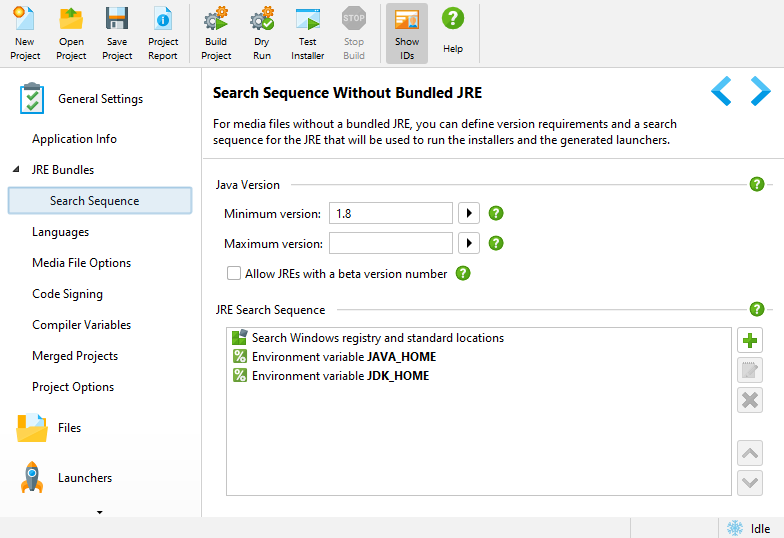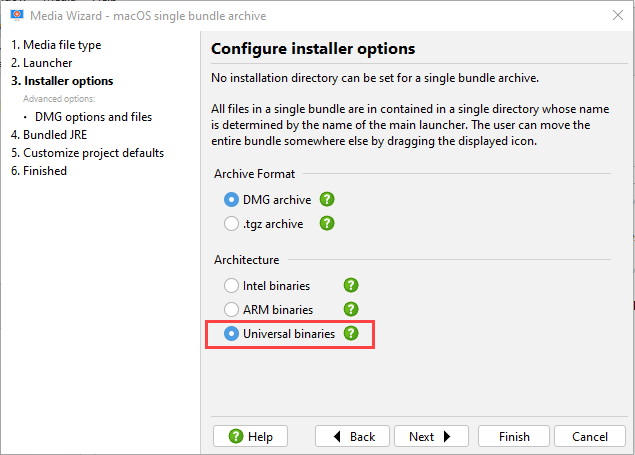
- #INSTALL4J JRE BUNDLE UPDATE#
- #INSTALL4J JRE BUNDLE SOFTWARE#
- #INSTALL4J JRE BUNDLE CODE#
- #INSTALL4J JRE BUNDLE TRIAL#
- #INSTALL4J JRE BUNDLE LICENSE#
At this time, select the jre bundle created earlier, or you can download it here (I have not used it)įirst click dry build without error. Then in the next step, you will be bound to a jre. Then continue to the next step to Installer, and then default to the next step to MediaĬontinue to the next step to choose a 64-bit system, I am a 64-bit system, need to check Then import the imported folder in the Files module to the classpath, and then set the program entry class: Step4: Double-click the New Launchers icon
#INSTALL4J JRE BUNDLE SOFTWARE#
The resource folder that needs to be emphasized here needs to be created in the software exactly, and then import the file under the corresponding folder Folder, folder import select directory, jar select single:Īfter adding, then continue to the next step to Launchers
p, -jdk-provider-id JDK provider ID for the JDK that is specified withStep3: Go to the Files module, click the green +, and then import the jar package and other resource folders under chat. This is not a version number, but a release string as shown on the 'JRE Bundles' step in the install4j IDE. Select the exe export directory and then always end the first module setting by default Select jre under the chat directory and then finished
#INSTALL4J JRE BUNDLE TRIAL#
Step1: Go to the official website to download a trial version, 90 days I only use it occasionally and activate it myself. %jre_home%\bin\java -classpath %class_path% -jar %base_home%\lib\chat_client.jar %jre_home%\lib\rt.jar %base_home%\lib\chat_client.jar The luncher is used to store the last generated exe. Then create a new chat folder in a certain directory, copy a jre and a png image, copy the directory of the project under the workspace (excluding project files and classes, etc.) to chat, and copy the folder in the lib folder Cut the package into jre's lib and ext, then copy the exported source jar package, and finally create a new directory. The corresponding jar package will appear under the specified directory. In this case, go out and refresh the project, and then finish. It may be reported that there is no synchronization error.
#INSTALL4J JRE BUNDLE CODE#
Just select the source code and set the export path

Then start to export as jar: right click on the project-> export The institutions under the working directory are as follows:Įither way, we need to export the source code as a jar package, see the picture above, create a manifest.mf file under the working directory to specify the program entryĬreated-By: 1.6.0_30 (Sun Microsystems Inc.) You can download a newer jetty.xml with only TLSv1.1 & TLSv1.2 protocol enabled, with a list of recommended strong cipher suites included by clicking on the jetty.xml link here.I made a java project and need to make it into something that exe or bat runs.
#INSTALL4J JRE BUNDLE LICENSE#
In order to fix this a new license file will be needed.

The MCU logs will display the message .licensing.InvalidLicense: Error verifying license: Invalid encoding for signature. When attempting to access MCU with an updated JRE 6, a HTTP ERROR: 503 will be displayed. This describes that Protocols TSLv1.1 and TLSv1.2 have been enabled out of SSLv2Hello, SSLv3, TLSv1, TSLv1.1, TLSv1.2 which are supported.Ī newer license file will be needed in order for MCU to work with the updated JRE, to get a new license please contact support. Oejhs.SslContextFactory:Enabled Protocols of When MCU server has finished loading look for a line similar to: $ C:\Program Files (x86)\Quest Software\Management Console for Unix\run_server.exe Validate that the new JRE is being used and that the desired Protocols are in use by running MCU from a command line. When using the IncludeProtocols set only protocols in the IncludeProcotols list will be considered by Jetty. You can enable protocols by setting the IncludeProtocols under the sslContextFactory in the MCU jetty.xml file.Ĭ:\Program Files (x86)\Quest Software\Management Console for Unix\etc\jetty.xml
#INSTALL4J JRE BUNDLE UPDATE#
Update jetty.xml to disable protocols that are not wanted like TLSv1, SSLv3, etc… by only enabling the protocols that are wanted. Step 2 – Define the EXE4J_JAVA_HOME variable in envirment variables. JreOld would suffice, the MCU Service will have to be stopped first.Ĭ:\Program Files (x86)\Quest Software\Management Console for Unix\jre Step 1 – Rename the jre folder to something else. Update the JRE path contained in the file /opt/quest/mcu/.install4j/inst_jre.cfg to point to the location of the Oracle Java JRE 1.6.0.121 or higher.Ĭhange /usr/local/java/jre1.6.0_45 to /usr/local/java/jre1.6.0_161 Oracle Java JRE 1.6.0_111 added support for TLSv1.1 and Oracle Java JRE 1.6.0._121 added support for TLSv1.2 ( Because of a bug found in OpenJDK 1.6.0.34 and higher that affects MCU 2.5.1 OpenJDK will not be able to be used) Safeguard for Privileged Sessions On Demand.Safeguard for Privileged Passwords On Demand.Safeguard Privilege Manager for Windows.One Identity Safeguard for Privileged Sessions (Balabit).


Active Directory Management and Security.


 0 kommentar(er)
0 kommentar(er)
